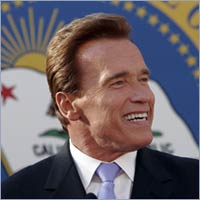LOS ANGELES /California Newswire/ — Continuing his commitment to alternative fuels and efficient, clean cars, Governor Arnold Schwarzenegger today highlighted the wide range of alternative fuel vehicles that will be on display at the 2009 L.A. Auto Show. This year’s show will feature over 1,000 of the 2010 makes and models of import and domestic cars, including many alternative fuel vehicles and several world and North American debuts.
 “In California, we have enacted ambitious, nation-leading environmental policies that have challenged automakers to innovate, to think beyond gasoline and to build cleaner, more efficient cars,” said Governor Schwarzenegger. “And, as we see here today at the 2009 L.A. Auto Show, automakers are rising to the challenge and giving drivers cleaner, more efficient options without sacrificing speed, performance or style. They are proving that it is possible to build a car that also protects the environment and I am excited to see more than 50 hybrids, plug-in hybrids, battery electrics, fuel-cell electrics and other alternative fuel vehicles on display at this year’s auto show.”
“In California, we have enacted ambitious, nation-leading environmental policies that have challenged automakers to innovate, to think beyond gasoline and to build cleaner, more efficient cars,” said Governor Schwarzenegger. “And, as we see here today at the 2009 L.A. Auto Show, automakers are rising to the challenge and giving drivers cleaner, more efficient options without sacrificing speed, performance or style. They are proving that it is possible to build a car that also protects the environment and I am excited to see more than 50 hybrids, plug-in hybrids, battery electrics, fuel-cell electrics and other alternative fuel vehicles on display at this year’s auto show.”
The 2009 L.A. Auto Show will feature more than 50 of the newest hybrids and alternative fuel vehicles including clean-diesel, electric, hydrogen fuel cell and ethanol powered vehicles. Hybrids remain the largest volume of green vehicles on display including the Toyota Prius, Honda Insight, Ford Fusion, Chevy Tahoe and the all new Mercedes-Benz S400. This year’s show will also feature more plug-ins and clean diesels than ever before including the BMW Vision Efficient Dynamics, Volkswagen Golf TDI and Volkswagen Jetta SportWagen TDI.
Developing a robust infrastructure to support alternative fuel vehicles and clean energy in California has been a top priority for Governor Schwarzenegger. In April 2004, the Governor launched an initiative to coordinate the deployment of hydrogen infrastructure to match the emerging California market for zero-emission hydrogen vehicles and buses. Since then, California has become home to the largest number of hydrogen stations in the world with a network of 16 stations in the greater Los Angeles area and another 10 throughout the rest of the state. Seven more stations are planned by 2010 for the Los Angeles region which will more than double the amount of hydrogen available to the public.
California has consistently led the nation and the world in setting policies that protect the environment and support clean vehicles. Under Governor Schwarzenegger’s leadership, California has enacted many policies that promote alternative fuel, clean energy and green jobs, including:
Low Carbon Fuel Standard (LCFS): California’s LCFS requires fuel providers to reduce the carbon intensity of transportation fuels sold in the state, dramatically expanding the market for alternative fuels. To start, the LCFS will reduce carbon content in all passenger vehicle fuels sold in California by at least 10 percent by 2020 and more thereafter.
• Alternative and Renewable Fuels Vehicle Technology Program: In 2007, Governor Schwarzenegger signed AB 118 by Former Assembly Speaker Fabian Nunez which established the Alternative and Renewable Fuels Vehicle Technology Program to fund the Research and Development of new technologies.
•Sales Tax Exemption for Zero Emission Vehicle Equipment: Last year, the Governor and Treasurer Bill Lockyer created a program to exempt manufacturing equipment for zero emission vehicle manufacturers from sales tax. This exemption is administered through the California Alternative Energy and Advanced Transportation Financing Authority.
•Automobile Emissions Standards: Due to Governor Schwarzenegger, California’s attempt to receive a federal waiver to reduce emissions from passenger vehicles has been granted. The Governor’s efforts also produced a national standard for cleaner, more fuel-efficient vehicles that will improve our environment and protect our economy.
•Global Warming Solutions Act of 2006 (AB 32): AB 32 established a first-in-the-world comprehensive program of regulatory and market mechanisms to achieve real, quantifiable, cost-effective reductions of greenhouse gas emissions. The law will reduce carbon emissions in California to 1990 levels by 2020.
•Renewable Portfolio Standard (RPS): Governor Schwarzenegger signed an Executive Order directing California Air Resources Board to adopt regulations increasing California’s RPS to 33 percent by 2020.







